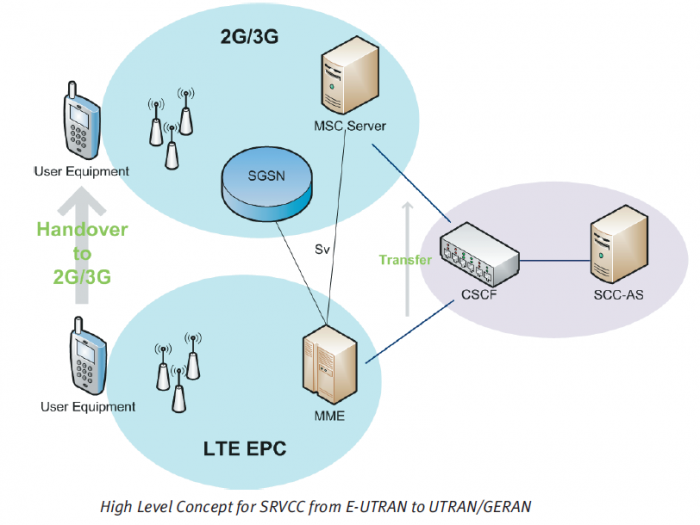SRVCC is a method for ensuring fast and reliable handover of an LTE user to a legacy network coverage area while it is in an active IMS based voice session. One challenge with SRVCC is to handover while the UE is connected to only a single radio at a given time. Two variations of SRVCC have been identified – UTRAN to 3GPP2 1xCS and E-UTRAN to 3GPP UTRAN/GERAN.
The UE, LTE Network, and Target Legacy Networks should all support SRVCC. In addition, a special interface known as Sv is formed between MME and MSC Server. The Sv interface is an interface between the Mobility Management Entity (MME) or Serving GPRS Support Node (SGSN) and 3GPP MSC server enhanced for SRVCC. The Sv interface is used to support Inter-RAT handover from VoIP/IMS over EPS to CS domain over 3GPP UTRAN/GERAN access. To support SRVCC the IMS network should also include application server called SCC-AS. The SCC (Service Centralization and Continuity) AS is responsible for handling the signalling required for the process below figure.

As the UE moves away from the LTE coverage area, LTE Reference Signal Transmit Power (RSTP) starts diminishing. The UE then notifies eNodeB about the change in the signal strength and SRVCC handover is initiated. The LTE network determines that the active voice call needs to be moved from the packet to the circuit domain. MME then receives the handover request from E-UTRAN with the indication that it is for SRVCC handling, and it then triggers the SRVCC procedure with the MSC Server via the Sv reference point.
A new voice call request is sent to the IMS using a special number known as STN-SR. STN-SR is a unique number that is generated for each UE and is stored in the HSS. This number is sent to the MME by the HSS when the UE first contacts with the network. Receiving STN-SR number indicates to the SCC-AS that the corresponding call needs to be routed to a different network, and it starts the redirection process to the legacy endpoint.
MME starts the handover of non-voice PS bearer during SRVCC procedure based on the information received from E-UTRAN. The handover of non-voice PS bearer(s) is done according to Inter-RAT handover procedure as defined in 3GPP Technical Specification 23.401. After the resource preparation is completed, MME confirms the handover request provided earlier by the eNodeB below figure.

The eNodeB then transmits the confirmation to the UE and provides the required information about the target network. When the mobile is detected in the legacy network, it switches its internal voice processing from VoLTE to legacy-circuit voice and the call is re-established.
3GPP Performance Requirements mandate the measured Voice Interruption Time to be within the 3GPP target of less than 0.3 seconds. Voice Interruption Time is the time between last voice packet on LTE and first on CS domain and is measurable through Inter-RAT handover delay. With legacy voice call retention rates typically higher than 98%, SRVCC handover is targeted to be successful more than 99% of the time. These established QoS standards target less than 0.3 seconds Voice Interruption Time and call drop rates and handover failure rates of less than one percent.
